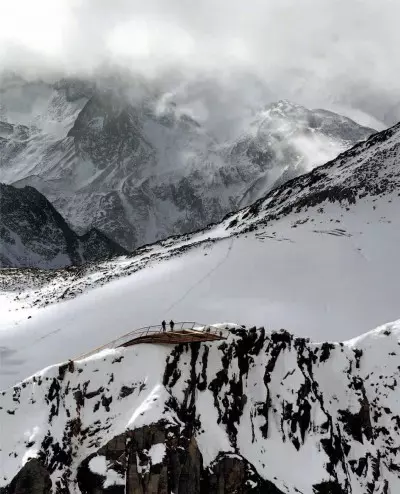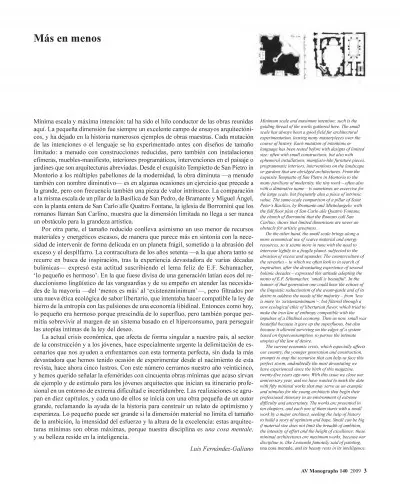OBRA MÍNIMA
50 Small Works
Luis Fernández-Galiano
Más en menos More in Less
Miradores: el paisaje Miradors: Landscape
Astearchitecture?Plataforma de observación, Tirol (Austria)?Viewing Platform, Tyrol (Austria)
Ateliereen Architecten?Torre-mirador, Reusel (Países Bajos)?Lookout Tower, Reusel (The Netherlands)
Architektur & Landschaft?Mirador, Brandeburgo (Alemania)?Observation Tower, Brandenburg (Germany)
70ºN arkitektur?Área de descanso, Torvdalshalsen (Noruega)?Rest Area, Torvdalshalsen (Norway)
Guallart Architects?Microcostas en Vinarós, Valencia (España)?Microcoasts in Vinarós, Valencia (Spain)
Aulas: la educación Classrooms: Education
Pasi Aalto?Orfanato Soe Ker Tie, Noh Bo (Tailandia)?Soe Ker Tie Orphanage, Noh Bo (Thailand)
Haugen Zohar Arkitekter?Aula infantil, Trondheim (Noruega)?Kindergarten Classroom, Trondheim (Norway)
Li Xiaodong Atelier?Escuela Puente, Fujian (China)?Bridge School, Fujian (China)
Pascale de Tourdonnet/L’Atelier Provisoire?Aula-taller, Burdeos (Francia)?Classroom-Workshop, Bordeaux (France)
Karo Architekten?Biblioteca al aire libre, Magdeburgo (Alemania)?Open-Air Library, Magdeburg (Germany)
Capillas: el culto Chapels: Worship
Luís Ferreira Rodrigues?Capilla de Santa Columbina, Gimonde (Portugal)?St. Columbina Chapel, Gimonde (Portugal)
Beton?Capilla de madera, Tarnów (Polonia)?Wooden Church, Tarnów (Poland)
Kunze Seeholzer?Capilla de San Benedicto, Kolbermoor (Alemania)?Chapel of St. Benedict, Kolbermoor (Germany)
Estudiantes del IIT de Chicago?Capilla en el campo, Bödigheim (Alemania)?Field Chapel, Bödigheim (Germany)
Moorhead & Moorhead?Capilla móvil, Fargo (Estados Unidos)?Mobile Chapel, Fargo (United States)
Galerías: el arte Galleries: Art
Antonio Jiménez Torrecillas?Pósito en Huescar, Granada (España)?Granary in Huescar, Granada (Spain)
studioMAS?Galería de Arte Circa, Johannesburgo (Sudáfrica)?Circa Art Gallery, Johannesburg (South Africa)
Hooper & m3architecture?Monumento a un árbol, Barcaldine (Australia)?Memorial to a Tree, Barcaldine (Australia)
Yasutaka Yoshimura?Contenedor expositivo, Tokio (Japón)?Exhibition Container, Tokyo (Japan)
Elisa Valero Ramos?Espacio para el arte en la sierra, Madrid (España)?Art Space in the Mountains, Madrid (Spain)
Estaciones: el viaje Stations: Journey
Netzwerk Architekten?Intercambiador, Darmstadt (Alemania)?Transport Interchange, Darmstadt (Germany)
Form-Art?Aparcamiento, Linz (Austria)?Parking Deck, Linz (Austria)
Baumschlager Eberle?Embarcadero, Fussach (Austria)?Pier, Fussach (Austria)
Subarquitectura?Parada de tranvía, Alicante (España)?Tram Stop, Alicante (Spain)
L3P Architekten?Aparcamiento para bicicletas, Zúrich (Suiza)?Bicycle Parking, Zurich (Switzerland)
Pabellones: la exhibición Pavilions: Exhibition
SANAA?Pabellón de la Serpentine Gallery, Londres (Reino Unido)?Serpentine Gallery Pavilion, London (United Kingdom)
Zaha Hadid?Pabellón de arte para Chanel, Nueva York (Estados Unidos)?Chanel Art Pavilion, New York (United States)
UNStudio?Pabellón Burnham, Chicago (Estados Unidos)?Burnham Pavilion, Chicago (United States)
OMA/AMO?Pabellón Transformer de Prada, Seúl (Corea del Sur)?Transformer Pavilion for Prada, Seoul (South Korea)
Tezuka Architects?Pabellón de madera, Ninotaira (Japón)?Wooden Pavilion, Ninotaira (Japan)
Estudios: el trabajo Studios: Work
Valerio Olgiati?Taller Bardill, Scharans (Suiza)?Atelier Bardill, Scharans (Switzerland)
Piet Hein Eek?Estudio para un músico, Hilversum (Países Bajos)?Studio for a Musician, Hilversum (The Netherlands)
Selgas & Cano?Estudio de arquitectura, Madrid (España)?Architecture Studio, Madrid (Spain)
dmvA Architecten?Oficina móvil (Bélgica)?Mobile Office (Belgium)
Korteknie & Stuhlmacher?Estudio para artistas, Utrecht (Países Bajos)?Studio for Artists, Utrecht (The Netherlands)
Refugios: la morada Shelters: Dwelling
Ensamble Studio?Casa en Costa da Morte, Galicia (España)?House on the Death Coast, Galicia (Spain)
Sanei Hopkins Architects?Casa móvil, Suffolk (Reino Unido)?Mobile Home, Suffolk (United Kingdom)
Sou Fujimoto?Cabaña de madera, Kumamoto (Japón)?Wooden Hut, Kumamoto (Japan)
Bearth & Deplazes/ETH Zürich?Refugio en Monte Rosa, Valais (Suiza)?Monte Rosa Shelter, Valais (Switzerland)
Baumraum?Casa en un árbol, Osnabrück (Alemania)?Treehouse, Osnabrück (Germany)
Equipamientos: el ocio Facilities: Leisure
Julien Boidot?Campamento de verano, Vaas (Francia)?Summer Campground, Vaas (France)
DJ Arquitectura?Piscina pública, Granada (España)?Public Swimming Pool, Granada (Spain)
Group 8?Aviario, Ginebra (Suiza)?Aviary, Geneva (Switzerland)
Pacific Environments Architects?Restaurante, Warkworth (Nueva Zelanda)?Restaurant, Warkworth (New Zealand)
White Arkitekter?Plataforma de baño, Kastrup (Copenhague)?Bathing Platform, Kastrup (Copenhagen)
Quioscos: el comercio Kiosks: Commerce
Wellmann Ladinger?Quiosco en Staufensee, Dornbirn (Austria)?Shack on the Staufensee, Dornbirn (Austria)
Spillmann Echsle Architekten?Tienda Freitag, Zúrich (Suiza)?Freitag Shop, Zürich (Switzerland)
Brut Deluxe?Quiosco m.poli, Madrid (España)?Kiosk m.poli, Madrid (Spain)
Topos Architecture?Quiosco de comida rápida, Saint-Nazaire (Francia)?Fast Food Stall, Saint-Nazaire (France)
Satoshi Ohtaki/Wood Program?Quiosco de helados, Hanko (Finlandia)?Ice Cream Stand, Hanko (Finland)
Luis Fernández-Galiano
More in Less
Minimum scale and maximum intention: such is the guiding thread of the works gathered here. The small scale has always been a good field for architectural experimentation, leaving many masterpieces over the course of history. Each mutation of intentions or language has been tested before with designs of limited size: often with small constructions, but also with ephemeral installations, manifesto-like furniture pieces, programmatic interiors, interventions on the landscape or gardens that are abridged architectures. From the exquisite Tempietto of San Pietro in Montorio to the many pavilions of modernity, the tiny work – often also with a diminutive name – is sometimes an excercise for the large scale, but frequently also a piece of intrinsic value. The same-scale comparison of a pillar of Saint Peter’s Basilica, by Bramante and Michelangelo. with the full floor plan of San Carlo alle Quattro Fontane, the church of Borromini that the Romans call San Carlino, shows that limited dimensions are never an obstacle for artistic greatness.
On the other hand, the small scale brings along a more economical use of scarce material and energy resources, so it seems more in tune with the need to intervene lightly in a fragile planet, subjected to the abrasion of excess and squander. The counterculture of the seventies – to which we often look to in search of inspiration, after the devastating experience of several bulimic decades – expressed this attitude adopting the motto of E.F.?Schumacher, ‘small is beautiful’. In the banner of that generation one could hear the echoes of the linguistic reductionism of the avant-garde and of its desire to address the needs of the majority – from ‘less is more’ to ‘existenzminimum’–, but filtered through a new ecological ethic of libertarian flavor, which tried to make the iron law of enthropy compatible with the impulses of a libidinal economy. Then as now, small was beautiful because it gave up the superfluous, but also because it allowed surviving on the edges of a system based on hyperconsumption, to pursue the intimate utopias of the law of desire.
The current economic crisis, which especially affects our country, the younger generation and construction, prompts to map the scenarios that can help us face this perfect storm, undoubtedly the most devastating we have experienced since the birth of this magazine, twenty-five years ago now. With this issue we close our anniversary year, and we have wanted to mark the date with fifty minimal works that may serve as an example and stimulus for the young architects that begin their professional itinerary in an environment of extreme difficulty and uncertainty. The works are presented in ten chapters, and each one of them starts with a small work by a major architect, seeking the help of history to build a story of optimism and hope. Small can be big if material size does not limit the breadth of ambition, the intensity of effort and the height of excellence: these minimal architectures are maximum works, because our discipline is, like?Leonardo famously said of painting, una cosa mentale, and its beauty rests in its intelligence.








